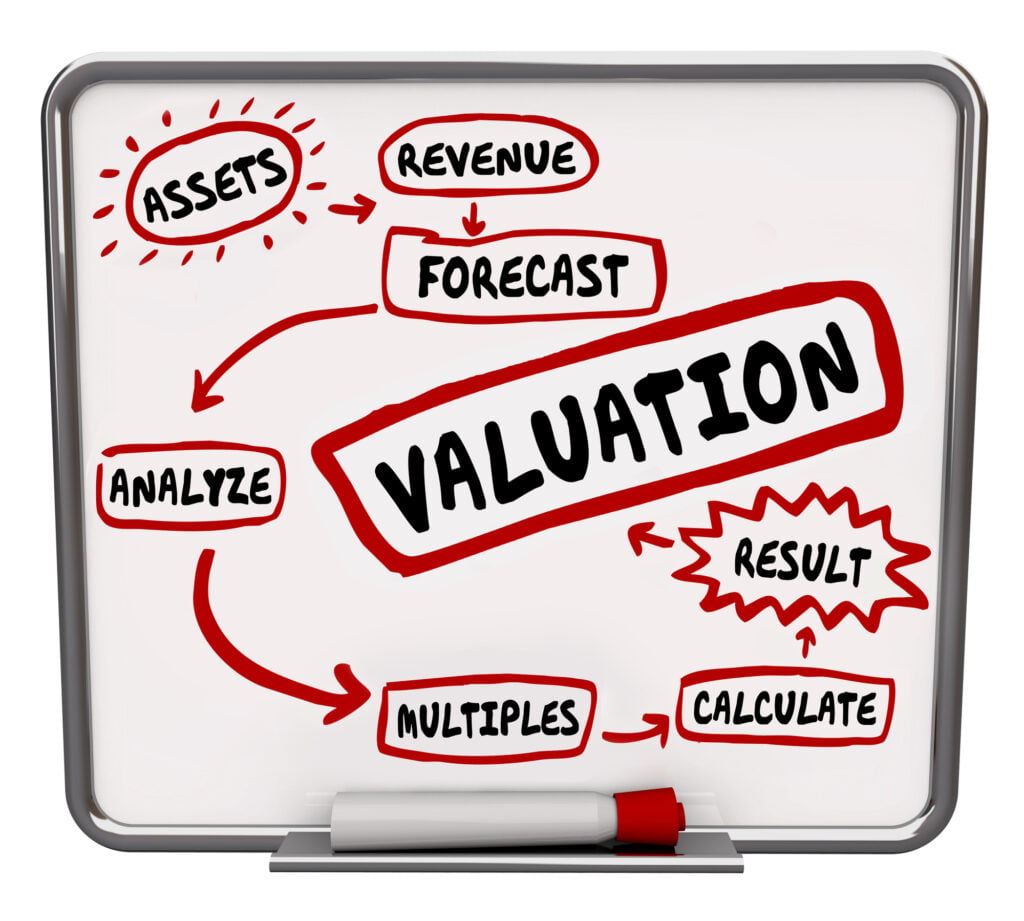
Pre Vs Post Money Valuation: What Entrepreneurs Need to Know
The difference in pre vs post money valuation is a key concept often address during Shark Tank. Pre-money valuation refers to the value of a company prior to receiving investment or financing. This figure is critical as it determines the percentage of ownership that new investors will receive in exchange for their capital. On the other hand, post-money valuation includes the recent investments and is essentially the company’s estimated worth after the investment has been made.
Table of Contents

When embarking on financing rounds, it is important for founders to have a firm grasp of their company in terms of both pre vs. post-money valuation. This helps understand how much of their company they are selling with each investment round.
Investors use these valuations to assess the risk and potential return on investment. To ensure a fair and beneficial deal for all parties involved, other valuation techniques might also come into play. Moreover, these valuations are a key aspect of the terms and legal negotiations of financing rounds. They serve as the foundation for the strategic considerations of both the entrepreneur who aims to raise capital without excessively diluting ownership, and investors who seek to maximize the potential return on their investment.
Key Takeaways
- Pre-money valuation refers to the value of a company before it goes public or receives external funding or financing. It does not include the latest round of financing.
- Post-money valuation includes the recent round(s) of financing and reflects the company’s value after receiving funding or external financing
- The main difference between these two lies in whether the company’s valuation includes or excludes the newest round of external financing.
Pre vs. Post-Money Valuation: the Basics

In this section, I’ll break down the core concepts of company valuation, focusing on the stages and methodologies used to derive at a company’s worth before and after an investment.
Valuation Fundamentals
Obtaining the correct valuation of your startup is an intricate financial analysis that determines the current worth of a company or asset. The process becomes crucial during various stages of a company’s life cycle, especially before and after raising capital. That’s where pre vs post money valuation comes into place, together with other methods. There are several ways to valuate a business, such as comparable company analysis, discounted cash flow (DCF) analysis, and asset-based valuations, each providing a different prismatic view of a company’s financial standing.
Pre-Money Valuation Explained
Pre-money valuation refers to the estimated value of a company before accepting new rounds of financing. Determining pre-money valuation is vital for investors and entrepreneurs because it influences the ownership percentage given away when new shares are issued. It serves as a baseline for negotiations during funding rounds and helps set valuation caps, which limit the price at which convertible notes can convert into equity.
Post-Money Valuation Explained
Post-money valuation, on the other hand, is the value of a company after it has received the new investments. It’s calculated by adding the pre-money valuation to the amount of new equity capital. This figure reflects the updated value of a company and directly affects the equity share each stakeholder holds. Post-money valuation is of particular interest to new investors, as it provides insight into the company’s new valuation after their financial commitment.
How Founders Use Pre vs Post Money Valuations
The concepts of pre vs post money valuation are crucial for accurately determining ownership stakes and preparing for the effects of dilution.
Calculating Equity Stake
For example, to determine my stake in early-stage startups and to leverage the concept of pre vs post money valuation, I can start by calculating the ownership percentage. I use a company’s pre-money valuation to establish its value before receiving any new investment. Here’s an example table showing the calculation:
| Investment Amount | Pre-Money Valuation | Post-Money Valuation | Founder Ownership Stake |
|---|---|---|---|
| $5M | $20M | $25M | 80% |
The post-money valuation is calculated by adding the new investment to the pre-money valuation. If my company receives a $5M investment at a $20M pre-money valuation, the post-money valuation would be $25M. To find my ownership percentage, I divide the pre-money valuation by the post-money valuation. Thus, my ownership percentage after the investment is 80%, representing a substantial interest in both common and preferred stock holdings.
Implications of Dilution on Founders

When new shares are issued to investors, my percentage of ownership decreases–this is dilution. For instance, if I initially owned 50% of the company through common stock and new investors receive preferred stock, my ownership percentage shrinks, though the total value of my equity might still increase if the company’s value rises. Crucial to consider is that dilution affects not just my stake but also the percentages held by other early shareholders and any co-founders. To make informed decisions about taking on new investment, I assess how dilution will influence my control over the company and future payouts from exits or dividends.
Financing Rounds Explained
When entrepreneurs look for external capital to fund their startups, they typically go through various stages of financing rounds. Each stage is crucial and caters to different levels of a company’s maturity, with unique types of investors participating. And this goes beyond the simpler pre vs post money valuation dichotomy.
Seed Funding and Series A
Seed Funding is the preliminary funding stage aimed at getting my startup off the ground. At this phase, I usually seek funds from angel investors — affluent individuals who believe in my company’s potential. The objective of seed funding is often to finance the initial steps, such as market research and product development.
Following seed funding, I may enter a Series A round. Series A rounds are more substantial and are typically led by venture capitalists. At the Series A level, I must demonstrate a track record with some traction and a clear plan for turning my business into a profitable venture. This is where I develop a scalable business model.
Following a Series A, there can be future rounds of funding, and they will be adjusted based on the new valuation of the company.
Understanding Convertible Notes and SAFEs
Convertible Notes are debt instruments that I use during the fundraising process, which convert into an amount of equity during a future financing round, typically the Series A. They are appealing because they allow me to delay setting a valuation for my company until it’s more mature.
SAFEs (Simple Agreements for Future Equity) serve a similar purpose to convertible notes but do not accrue interest. As an entrepreneur, I find SAFEs simpler than convertible notes since they are not debt and therefore reduce the potential financial burden in my company’s nascent stages.
Other Valuation Techniques

In valuing startups, alongside pre-money and post-money valuations, financial analysts often employ methods like DCF and comparables analysis. These approaches provide a multi-faceted view of a company’s financial health and potential for growth.
Discounted Cash Flow (DCF) Analysis
I use DCF analysis to estimate the present value of an expected stream of future cash flows from the business. By discounting these cash flows at a rate reflecting the cost of capital and risks involved, I can determine the value of assets, which is especially pertinent when assessing a startup’s long-term scalability and growth outlook. In DCF, precise inputs related to revenue generation and cost structures are critical; they feed into projecting free cash flows, which are then discounted to the present value.
Key elements of a DCF model include:
- Projected revenue growth: Startups are often characterized by high growth rates, affecting future cash flows.
- Estimation of costs and expenses: An accurate forecast of the cost base is essential in determining the net cash flows.
- Discount rate: Typically reflective of the weighted average cost of capital (WACC), taking into account the risk profile of the startup.
Comparables Analysis
I perform comparables analysis to assess a startup’s value by comparing it to similar companies in the industry, based on metrics such as price-to-earnings (P/E) ratios, enterprise value-to-revenue (EV/Revenue) ratios, or other relevant financial ratios. This approach relies on the availability of a robust set of comparable companies with publicly disclosed financials, which can pose a challenge when valuing unique or innovative startups.
Below is a table illustrating a simplified comparable analyses:
| Metric | Startup | Comparable Company A | Comparable Company B |
|---|---|---|---|
| Price-to-Earnings (P/E) Ratio | – | 25x | 30x |
| Enterprise Value/Revenue (EV/R) | 10x | 12x | 15x |
| Revenue Growth Rate | 200% | 10% | 12% |
| EBITDA Margin | -5% | 20% | 18% |
*Note: “-” indicates a metric that is not applicable or not available for the startup due to negative earnings or undisclosed financials.
In summary, my approach integrates a nuanced understanding of financial metrics and market benchmarks to arrive at a comprehensive valuation. Through meticulous analysis of cash flows and comparative business models, I contribute to a clearer financial picture suited for investment decision-making.
Legal and Term Negotiations
It is paramount to seek legal advice during the funding process, understanding the intricacies of legal terms and efficiently negotiating them can significantly affect the share price and the overall equity value of a business.
Navigating Term Sheets
When I examine term sheets, I focus closely on offer details that determine the pre and post-money valuation. The terms often include valuation caps and fully diluted capitalization, which can alter the company’s worth and my shareholding percentage after the investment round. It’s crucial that I meticulously review these terms to comprehend their long-term implications on equity value.
Engaging with Lawyers
Company founders should always engage with lawyers to navigate the complex legal landscape surrounding funding rounds. An expert lawyer will diligently work with me to ensure that the offer terms protect my interests and precisely reflect the agreed-upon valuation of my company. By working closely with a lawyer, I safeguard my position during negotiations and secure fair terms that reflect the true value of my venture.
Strategic Considerations for Entrepreneurs

When navigating pre-money and post-money valuations, I must weigh the implications each has on my venture’s current and future financial landscape.
Preparing for Future Investments
In preparing for future investments, I need to establish a pre-money value that accurately reflects my company’s worth before adding new capital. This is crucial as it determines my ownership percentage once investors come on board. By setting a realistic pre-money valuation, I can attract potential investors without significantly diluting my equity. It’s essential to account for my company’s assets, intellectual property, market position, and growth trajectory when setting this figure.
Avoiding Down Rounds
A down round occurs when I raise capital at a valuation lower than the post-money value of the previous round of financing. This can damage my company’s reputation, shake investor confidence, and cause dilution of existing shareholders more than expected. To avoid down rounds, I must monitor my burn rate and set actionable milestones that demonstrate growth, thereby justifying my company’s valuation at or above the previous round.
Here is an example table that might assist in appreciating the impact of strategic valuation planning:
| Investment Round | Pre-Money Valuation | Investment Amount | Post-Money Valuation | Ownership Post-Investment |
|---|---|---|---|---|
| Series A | $20 million | $5 million | $25 million | 80% retained |
| Series B | $30 million | $10 million | $40 million | 75% retained |
My goal in each funding round is to maximize my company’s valuation while preserving my ownership percentages, thus retaining significant control and benefiting from future value increases.
Equity Distribution and Valuation
In equity distribution, striking the right balance is crucial, as it impacts both the company’s valuation and the long-term incentives for employees and founders.
Stock Options and Employee Equity
In my experience, stock options represent a significant component of employee compensation, especially in startups. I allocate these options from a pool set aside for employees, which typically ranges from 10% to 20% of the company’s equity. This is a compelling way to attract and retain talent, as employees stand to gain if the company’s value increases over time. The equity offered is often calculated based on a pre-money valuation. For example, if I’m granting options to a key hire when my startup has a pre-money valuation of $5 million, the percentage granted determines their potential future stake in the company after subsequent funding rounds.
Startup Valuations for Pre-Revenue Companies
When dealing with pre vs post money valuation, and I look at pre-revenue startups, valuation can be more art than science. I rely on various methods such as Comparables Analysis or Discounted Cash Flow (DCF) analysis. I must be strategic about assigning a pre-money valuation with a realistic yet optimistic view of the company’s growth potential.
For instance, a complex model I may use estimates the future cash flows and discounts them back to their present value, which forms the basis of the valuation. This pre-revenue valuation influences how much equity I will have to give up in exchange for capital. Maintaining a strong position during negotiations is vital since early valuations set the stage for future financing rounds and thereby the overall equity distribution among founders, investors, and employees.
Conclusion
In conclusion, understanding the difference between pre vs post-money valuation is crucial for entrepreneurs seeking investment opportunities. The ability to leverage this knowledge can greatly benefit business owners and professionals, particularly when engaging in investment discussions such as those found on platforms like Shark Tank. By grasping the nuances of pre vs post-money valuation, entrepreneurs can effectively navigate funding negotiations and make informed decisions about the future growth and success of their enterprises.







